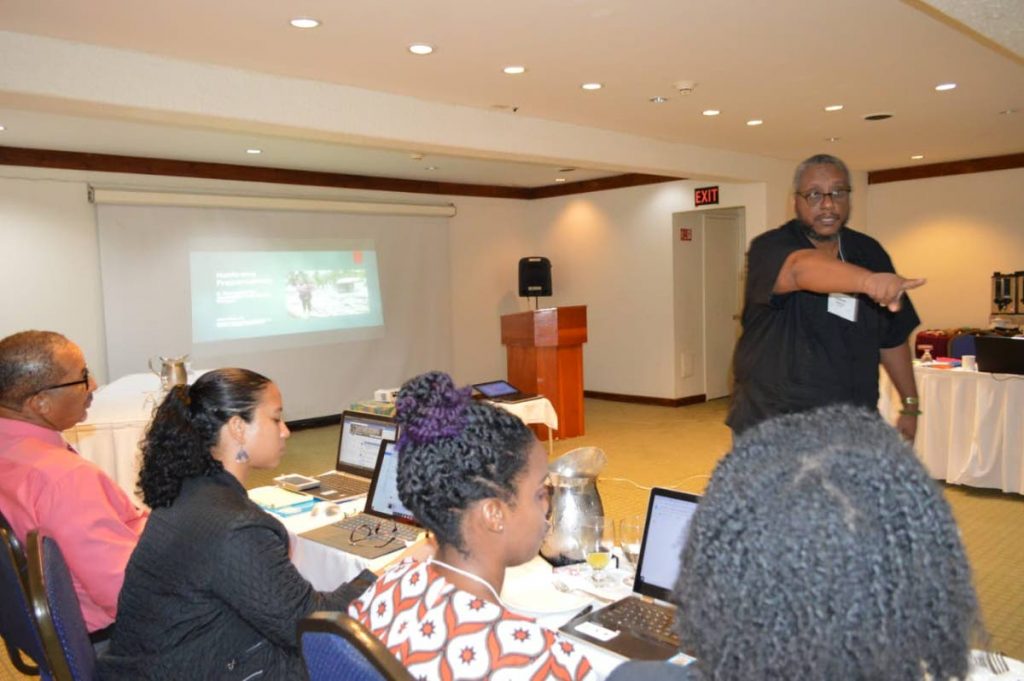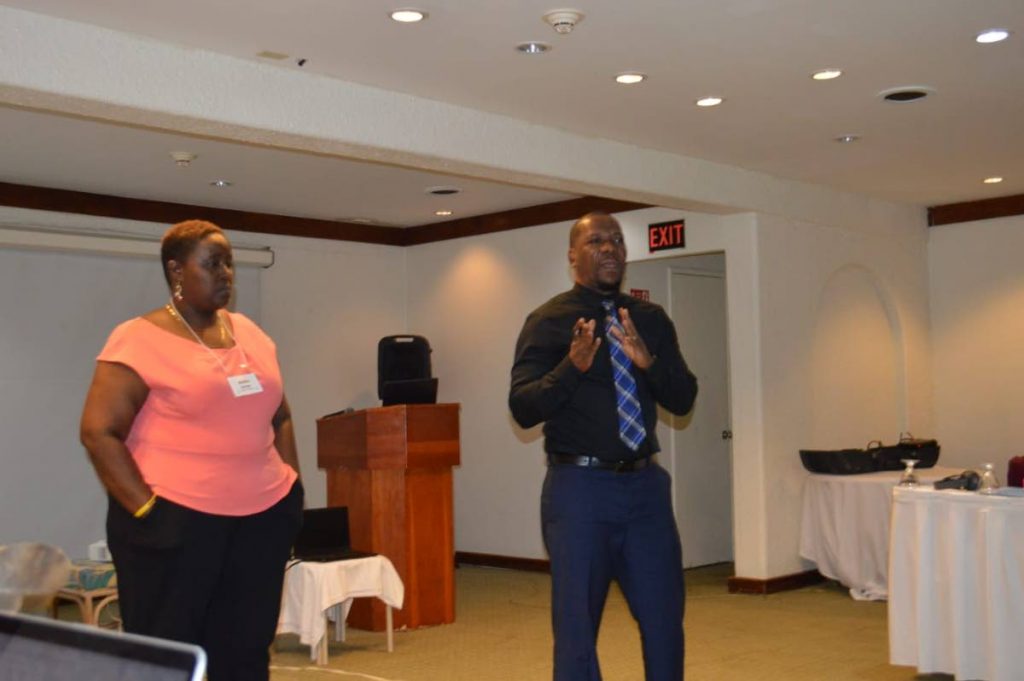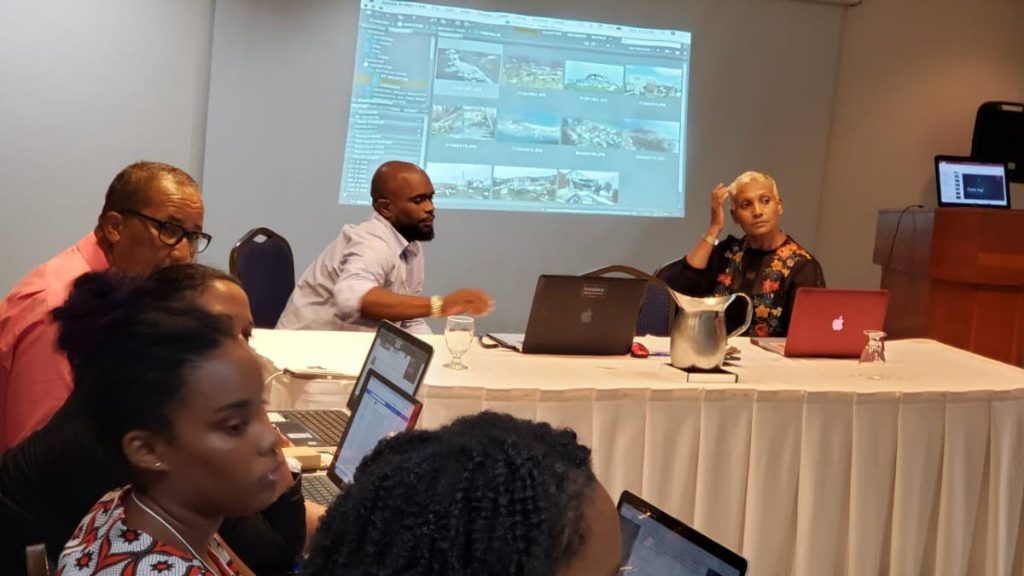Regional media trained in covering hurricanes

CHILDREN remain the most vulnerable group in a natural disaster, and the most vulnerable out of that group are poor children.
That was the assessment outlined by Julius Gittens, principal consultant at Herald Partners and co-editor of Barbados Today, to journalists attending the Association for Caribbean Media Workers’ workshop in Antigua on media coverage of children in disaster.
Every year between June and November the Atlantic hurricane season threatens the Caribbean with weather systems that range from tropical storms to category five hurricanes.
On October 7 and 8, media practitioners from around the region took part in the workshop, hosted by the Association and Unicef office of the Eastern Caribbean in Antigua and Barbuda.
Barbuda was hit by Hurricane Irma in September 2017, and on the second day of the workshop the group went to the island to experience the aftermath.
The first day was a theoretical training session delivered by Gittens and the association’s president Anika Kentish, an Antiguan-based freelance journalist who talked about the guiding principles of disaster journalism.

There are three phases of covering a natural hazard: before the event, when one must find out how prepared the country is; during, so people can be given up-to-date information on what’s happening; and the recovery and rebuilding stage.
"Failing to plan is a plan to fail" was the maxim Gittens cited as he urged every media house in the Caribbean to come up with a plan for such events. For the safety of the journalists covering the storm stories, media houses should make a risk-assessment plan.
Long before a storm, a media house should know how to deploy its staff, know how many essential personnel it needs and stock enough food supplies for all staff there. This was essential, as journalists are as vulnerable to the storm as everyone else.
Before the media can be responsible for informing the country, they should check in at home to ensure their family’s safety, that way they can stay focused and calm while out on the field.
Gittens recalled the biggest regret of his father Keith Gittens, from Caribbean Broadcasting Corporation (CBC) Television, which was leaving his family at home while he went to cover Hurricane Allen on August 4, 1980. He said his mother and teenage sons were home trying to fortify their home – as he picked up his camera and rushed off.

“You have to put on your life jacket before you can put on someone else’s,” Gittens said.
The media house should also have a designated sleeping area in mind in case staff need to stay for prolonged periods. Both the individual worker and the company should have equipment such as flashlights, battery packs, solar-powered flashlights, solar-powered chargers and extra batteries prepared as well. Media houses and individual journalists should also prepare themselves with items such as biscuits, canned tuna, protein bars and nuts to last up to 72 hours.
Radio broadcast was established as a critical part of disaster communication. Radio delivers the fastest and most up-to-date information, and all cell phones have radios programmed into them. Gittens cautioned, however, against radio stations, particularly religious ones, trying to "pray the storm away" by playing religious music non-stop instead of keeping the public informed.
As journalists are on the front line of traumatic events, Gittens raised concerns about their mental health, saying there should be systems in place to support journalists who need help in that area.
Kentish discussed the role social media played in disaster coverage. While they can be an asset in disseminating information, they can cause a lot of harm when false information and inaccurate photos and videos circulate online.
Journalists can also use Google Maps and Google Street View to see if locations are accurate.
On reporting on people, Kentish encouraged all the journalists to practise affirmative consent, speak to victims with compassion and empathy and not to trespass on private property just to get a story.
She said many times people want to tell their stories and it is a form of catharsis for them to process trauma, but a journalist must be tactful in his or herapproach. She suggested asking victims what happened and if they feel up to talking.
“You cannot go into a disaster zone where people have lost everything and approach a victim and ask them how they feel,” Kentish said.
She said photographers play an essential role in hurricane coverage. The jarring images of the devastation the photographers capture may go viral and compel people to help.
However, Kentish implored journalists to put themselves into their subject’s shoes and ask if they would like to see their personal belongings floating around in water and their homes destroyed on the news.
According to the theory of quantum mechanics, a body behaves differently under observation tfrom the way does in real life. No one can tell the true shape of an atom, because it changes when scientists try to observe. The same is true for humans: people act differently when they are not aware someone is looking. So the issue of consent for photography was raised during the discussion, as photojournalists often take candid photos.
Mohammid Walbrook, a Barbudan photographer, was on the island when Irma hit. He made sure his parents had evacuated to Antigua and stayed behind with his cousins to film the storm. He showed a video of his cousins hiding in the bathroom, as rain forced its way into their home. His home was destroyed during the storm and he camped out in a tent for ten months.
He documented the recovery process after Irma and took photos of the children who stayed behind. In the case of children, permission should be sought from parents, principals and guardians before publishing their photos. He said once he got permission from the parents, he would publish the pictures, and if the children resisted or looked as if they did not want their pictures taken, then he would not do so.
Unicef produced a booklet, Our Children, Our Media: A Guide for Caribbean Practitioners, which is available online for download. Kentish and Gittens encouraged all journalists to read it to understand how to cover children while respecting their fundamental human rights.
Keep reading the Hurricane Series for more stories on Irma and children in trauma.


Comments
"Regional media trained in covering hurricanes"